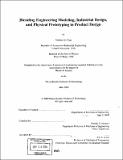Blending engineering modeling, industrial design, and physical prototyping in product design
Author(s)
Page, Matthew E. (Matthew Edwin), 1975-
DownloadFull printable version (9.452Mb)
Other Contributors
Massachusetts Institute of Technology. Dept. of Mechanical Engineering.
Advisor
Woodie C. Flowers.
Terms of use
Metadata
Show full item recordAbstract
Engineering simulation models, industrial design form models, and physical experimentation through prototypes are critical elements of successful product design. However, the three disciplines are disconnected and the direction of simulations, form models, and physical prototypes often diverge increasingly as product detail is developed. This divergence often results in an expensive and time consuming design cycle and inferior product quality. The first 10% of the cycle is taken up largely by conceptual design, an iterative stage that requires close interaction between industrial designers, modelers and engineers. In the current state of the art, information is often lost when models are approximately reconstructed from physical prototypes, CAD or surface models. A new approach to the conceptual design cycle is developed and applications for the design of consumer products are discussed. The tools that make up the cycle work together to create a flexible, iterative design environment. Industrial designers, engineers, and modelers generate and exchange form concepts, alternating between physical and digital representations of product geometry. Rapid alternation between the physical and digital domain is enabled and information flow between iterations is improved.
Description
Thesis (S.M.)--Massachusetts Institute of Technology, Dept. of Mechanical Engineering, 2000. Includes bibliographical references (leaves 63-64).
Date issued
2000Department
Massachusetts Institute of Technology. Department of Mechanical EngineeringPublisher
Massachusetts Institute of Technology
Keywords
Mechanical Engineering.